Higher National Diploma: Management and Operations Report - KPMG
VerifiedAdded on 2023/01/06
|20
|6738
|38
Report
AI Summary
This report analyzes management and operations within KPMG, a global consultancy firm. It differentiates between the characteristics and roles of leaders and managers, exploring their functions in various organizational situations, including change implementation and conflict resolution. The report examines leadership theories, such as situational and system leadership, and evaluates their strengths and weaknesses. It further discusses key approaches to operations management, emphasizing the roles of leaders and managers in improving operational efficiencies. The report also analyzes the factors within the business environment that impact operational management and decision-making. The report covers various leadership styles, hard and soft skills, and the importance of operational management in achieving business objectives. The analysis includes Management by Objectives (MBO) and its significance and limitations. The report concludes with a critical evaluation of the application of operation management and its impact on the organization.
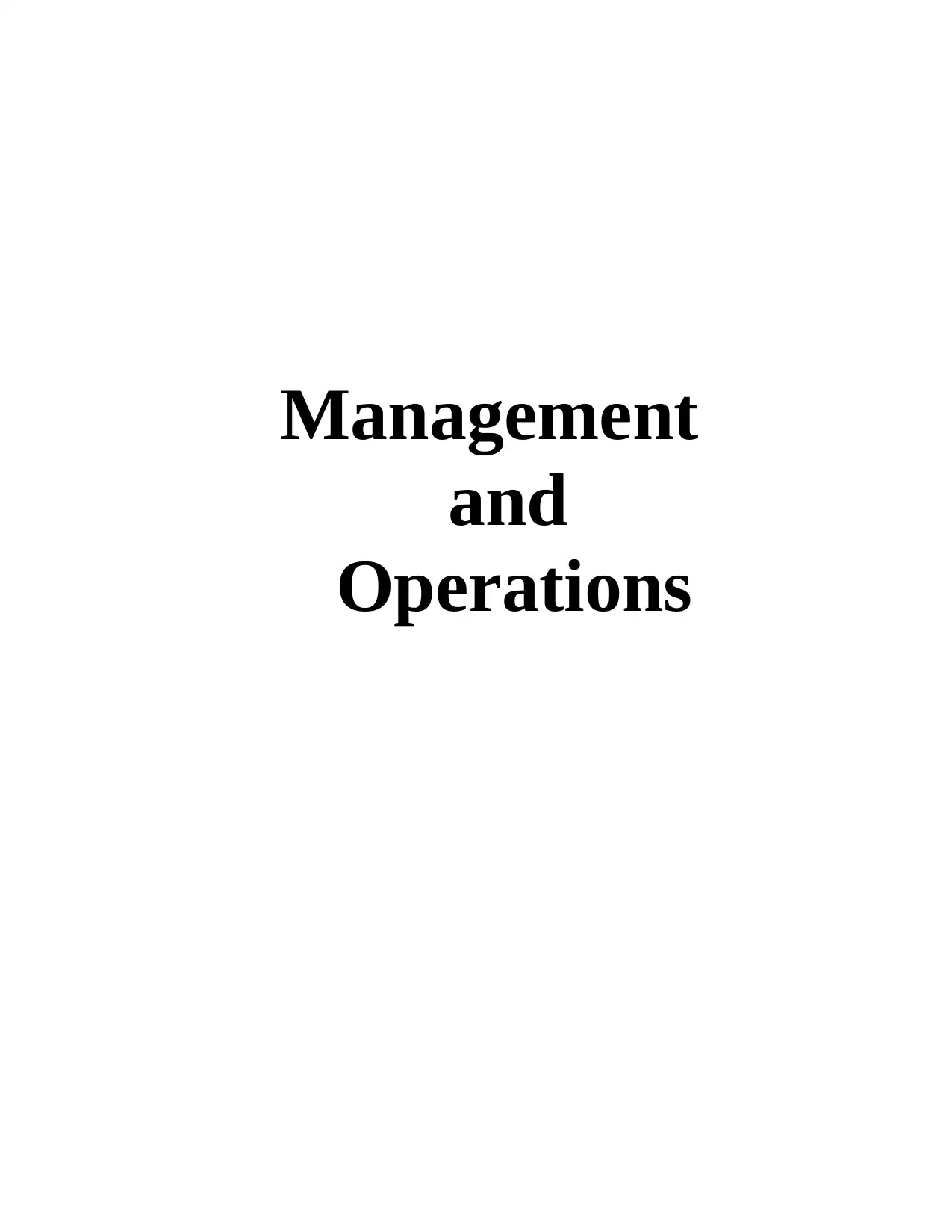
Management
and
Operations
and
Operations
Paraphrase This Document
Need a fresh take? Get an instant paraphrase of this document with our AI Paraphraser
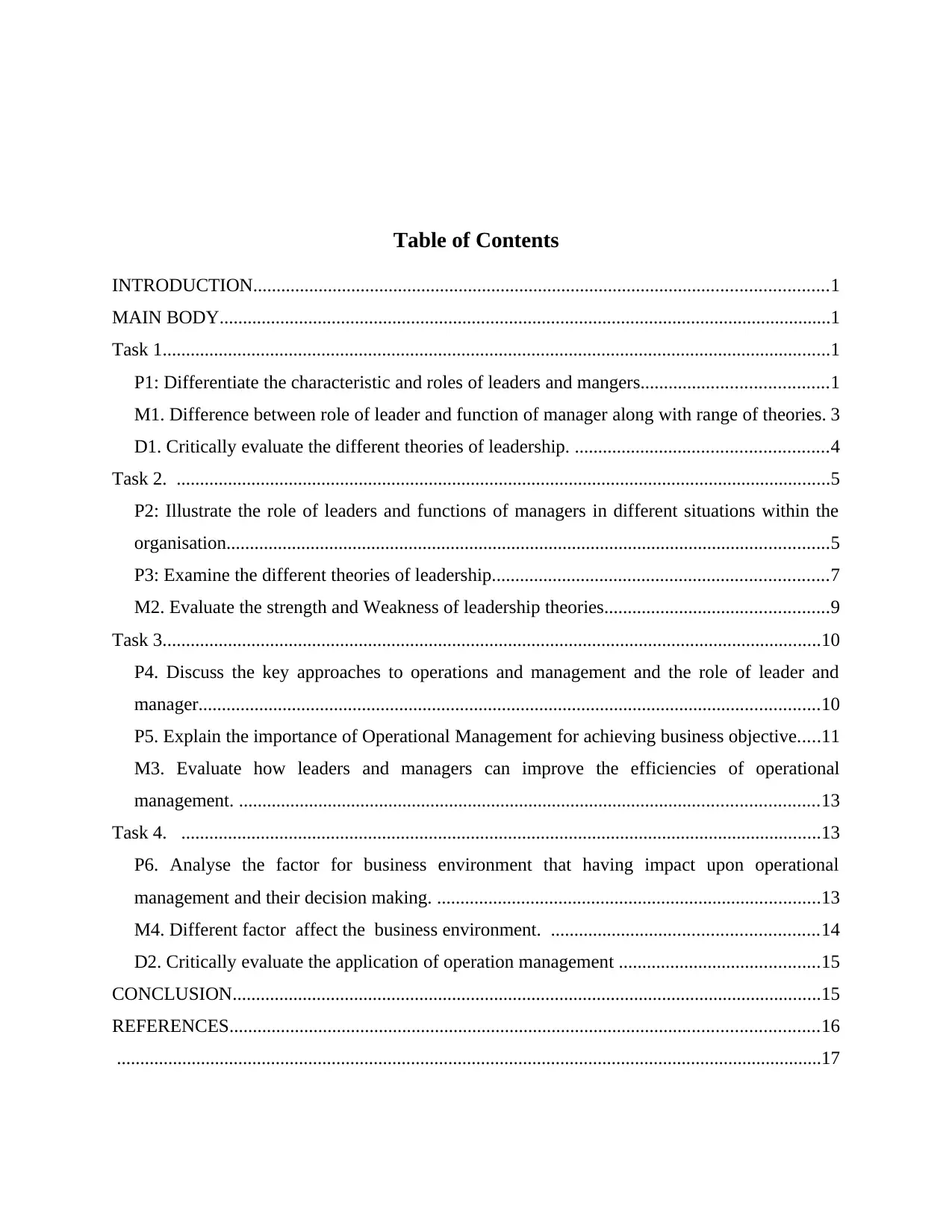
Table of Contents
INTRODUCTION...........................................................................................................................1
MAIN BODY...................................................................................................................................1
Task 1...............................................................................................................................................1
P1: Differentiate the characteristic and roles of leaders and mangers........................................1
M1. Difference between role of leader and function of manager along with range of theories. 3
D1. Critically evaluate the different theories of leadership. ......................................................4
Task 2. ............................................................................................................................................5
P2: Illustrate the role of leaders and functions of managers in different situations within the
organisation.................................................................................................................................5
P3: Examine the different theories of leadership........................................................................7
M2. Evaluate the strength and Weakness of leadership theories................................................9
Task 3.............................................................................................................................................10
P4. Discuss the key approaches to operations and management and the role of leader and
manager.....................................................................................................................................10
P5. Explain the importance of Operational Management for achieving business objective.....11
M3. Evaluate how leaders and managers can improve the efficiencies of operational
management. ............................................................................................................................13
Task 4. .........................................................................................................................................13
P6. Analyse the factor for business environment that having impact upon operational
management and their decision making. ..................................................................................13
M4. Different factor affect the business environment. .........................................................14
D2. Critically evaluate the application of operation management ...........................................15
CONCLUSION..............................................................................................................................15
REFERENCES..............................................................................................................................16
.......................................................................................................................................................17
INTRODUCTION...........................................................................................................................1
MAIN BODY...................................................................................................................................1
Task 1...............................................................................................................................................1
P1: Differentiate the characteristic and roles of leaders and mangers........................................1
M1. Difference between role of leader and function of manager along with range of theories. 3
D1. Critically evaluate the different theories of leadership. ......................................................4
Task 2. ............................................................................................................................................5
P2: Illustrate the role of leaders and functions of managers in different situations within the
organisation.................................................................................................................................5
P3: Examine the different theories of leadership........................................................................7
M2. Evaluate the strength and Weakness of leadership theories................................................9
Task 3.............................................................................................................................................10
P4. Discuss the key approaches to operations and management and the role of leader and
manager.....................................................................................................................................10
P5. Explain the importance of Operational Management for achieving business objective.....11
M3. Evaluate how leaders and managers can improve the efficiencies of operational
management. ............................................................................................................................13
Task 4. .........................................................................................................................................13
P6. Analyse the factor for business environment that having impact upon operational
management and their decision making. ..................................................................................13
M4. Different factor affect the business environment. .........................................................14
D2. Critically evaluate the application of operation management ...........................................15
CONCLUSION..............................................................................................................................15
REFERENCES..............................................................................................................................16
.......................................................................................................................................................17
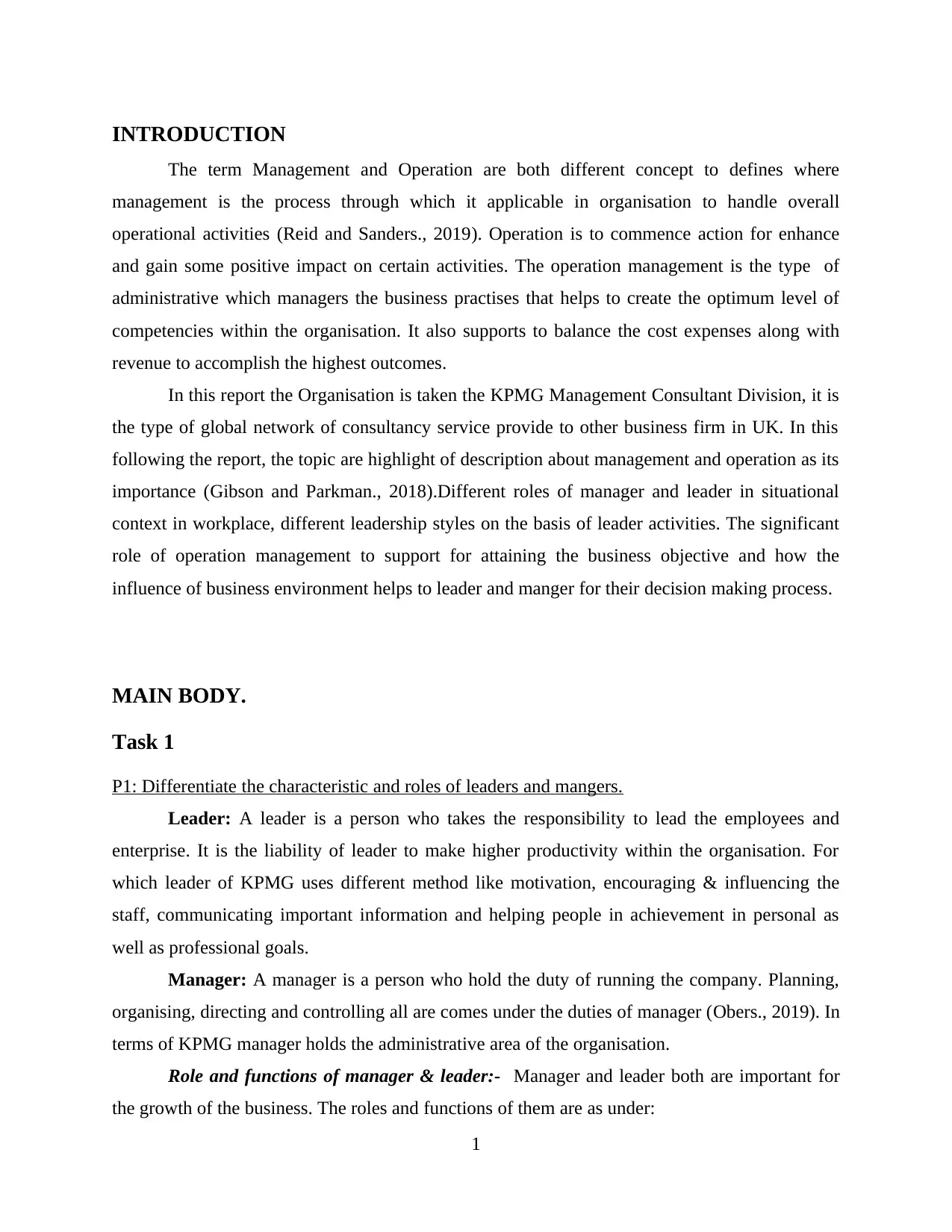
INTRODUCTION
The term Management and Operation are both different concept to defines where
management is the process through which it applicable in organisation to handle overall
operational activities (Reid and Sanders., 2019). Operation is to commence action for enhance
and gain some positive impact on certain activities. The operation management is the type of
administrative which managers the business practises that helps to create the optimum level of
competencies within the organisation. It also supports to balance the cost expenses along with
revenue to accomplish the highest outcomes.
In this report the Organisation is taken the KPMG Management Consultant Division, it is
the type of global network of consultancy service provide to other business firm in UK. In this
following the report, the topic are highlight of description about management and operation as its
importance (Gibson and Parkman., 2018).Different roles of manager and leader in situational
context in workplace, different leadership styles on the basis of leader activities. The significant
role of operation management to support for attaining the business objective and how the
influence of business environment helps to leader and manger for their decision making process.
MAIN BODY.
Task 1
P1: Differentiate the characteristic and roles of leaders and mangers.
Leader: A leader is a person who takes the responsibility to lead the employees and
enterprise. It is the liability of leader to make higher productivity within the organisation. For
which leader of KPMG uses different method like motivation, encouraging & influencing the
staff, communicating important information and helping people in achievement in personal as
well as professional goals.
Manager: A manager is a person who hold the duty of running the company. Planning,
organising, directing and controlling all are comes under the duties of manager (Obers., 2019). In
terms of KPMG manager holds the administrative area of the organisation.
Role and functions of manager & leader:- Manager and leader both are important for
the growth of the business. The roles and functions of them are as under:
1
The term Management and Operation are both different concept to defines where
management is the process through which it applicable in organisation to handle overall
operational activities (Reid and Sanders., 2019). Operation is to commence action for enhance
and gain some positive impact on certain activities. The operation management is the type of
administrative which managers the business practises that helps to create the optimum level of
competencies within the organisation. It also supports to balance the cost expenses along with
revenue to accomplish the highest outcomes.
In this report the Organisation is taken the KPMG Management Consultant Division, it is
the type of global network of consultancy service provide to other business firm in UK. In this
following the report, the topic are highlight of description about management and operation as its
importance (Gibson and Parkman., 2018).Different roles of manager and leader in situational
context in workplace, different leadership styles on the basis of leader activities. The significant
role of operation management to support for attaining the business objective and how the
influence of business environment helps to leader and manger for their decision making process.
MAIN BODY.
Task 1
P1: Differentiate the characteristic and roles of leaders and mangers.
Leader: A leader is a person who takes the responsibility to lead the employees and
enterprise. It is the liability of leader to make higher productivity within the organisation. For
which leader of KPMG uses different method like motivation, encouraging & influencing the
staff, communicating important information and helping people in achievement in personal as
well as professional goals.
Manager: A manager is a person who hold the duty of running the company. Planning,
organising, directing and controlling all are comes under the duties of manager (Obers., 2019). In
terms of KPMG manager holds the administrative area of the organisation.
Role and functions of manager & leader:- Manager and leader both are important for
the growth of the business. The roles and functions of them are as under:
1
⊘ This is a preview!⊘
Do you want full access?
Subscribe today to unlock all pages.

Trusted by 1+ million students worldwide
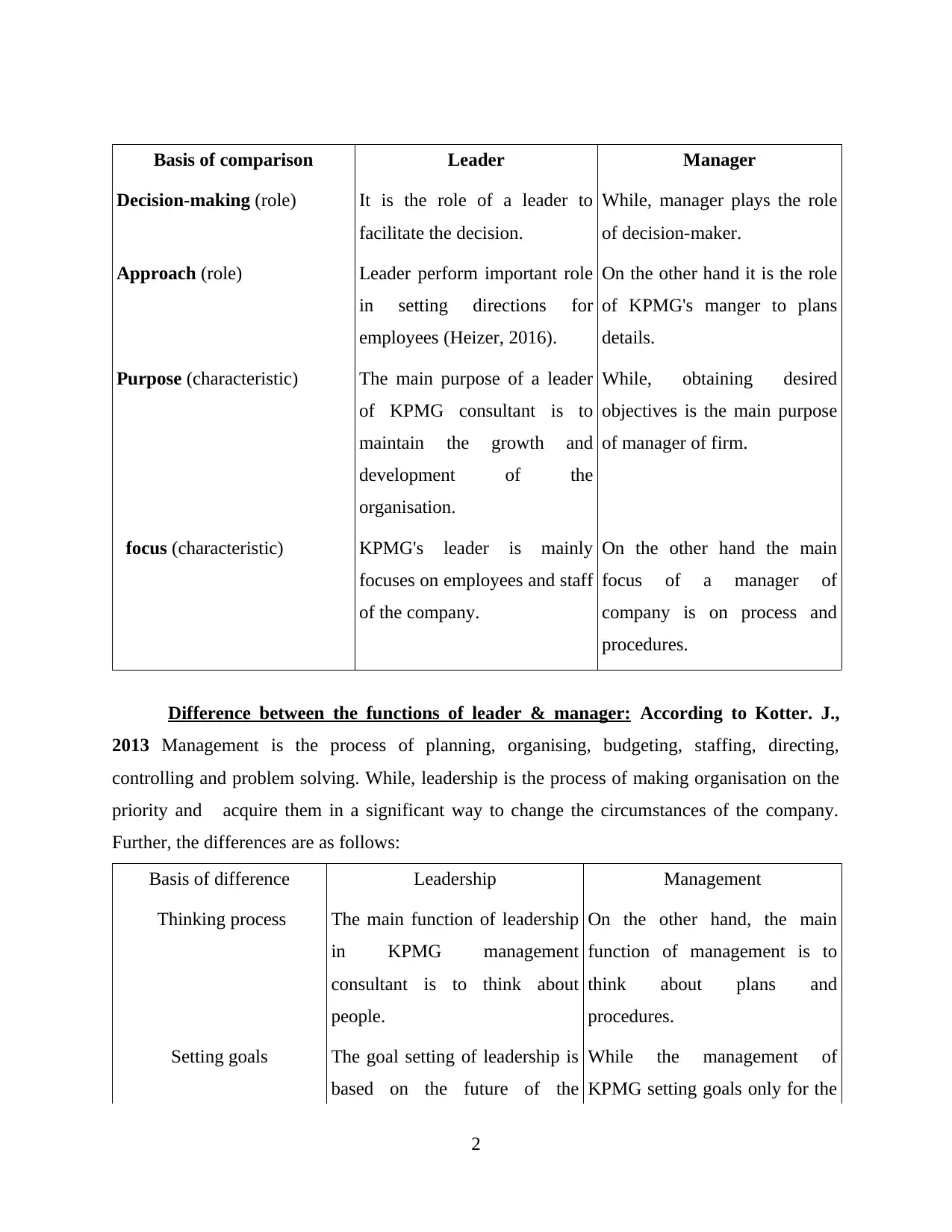
Basis of comparison Leader Manager
Decision-making (role) It is the role of a leader to
facilitate the decision.
While, manager plays the role
of decision-maker.
Approach (role) Leader perform important role
in setting directions for
employees (Heizer, 2016).
On the other hand it is the role
of KPMG's manger to plans
details.
Purpose (characteristic) The main purpose of a leader
of KPMG consultant is to
maintain the growth and
development of the
organisation.
While, obtaining desired
objectives is the main purpose
of manager of firm.
focus (characteristic) KPMG's leader is mainly
focuses on employees and staff
of the company.
On the other hand the main
focus of a manager of
company is on process and
procedures.
Difference between the functions of leader & manager: According to Kotter. J.,
2013 Management is the process of planning, organising, budgeting, staffing, directing,
controlling and problem solving. While, leadership is the process of making organisation on the
priority and acquire them in a significant way to change the circumstances of the company.
Further, the differences are as follows:
Basis of difference Leadership Management
Thinking process The main function of leadership
in KPMG management
consultant is to think about
people.
On the other hand, the main
function of management is to
think about plans and
procedures.
Setting goals The goal setting of leadership is
based on the future of the
While the management of
KPMG setting goals only for the
2
Decision-making (role) It is the role of a leader to
facilitate the decision.
While, manager plays the role
of decision-maker.
Approach (role) Leader perform important role
in setting directions for
employees (Heizer, 2016).
On the other hand it is the role
of KPMG's manger to plans
details.
Purpose (characteristic) The main purpose of a leader
of KPMG consultant is to
maintain the growth and
development of the
organisation.
While, obtaining desired
objectives is the main purpose
of manager of firm.
focus (characteristic) KPMG's leader is mainly
focuses on employees and staff
of the company.
On the other hand the main
focus of a manager of
company is on process and
procedures.
Difference between the functions of leader & manager: According to Kotter. J.,
2013 Management is the process of planning, organising, budgeting, staffing, directing,
controlling and problem solving. While, leadership is the process of making organisation on the
priority and acquire them in a significant way to change the circumstances of the company.
Further, the differences are as follows:
Basis of difference Leadership Management
Thinking process The main function of leadership
in KPMG management
consultant is to think about
people.
On the other hand, the main
function of management is to
think about plans and
procedures.
Setting goals The goal setting of leadership is
based on the future of the
While the management of
KPMG setting goals only for the
2
Paraphrase This Document
Need a fresh take? Get an instant paraphrase of this document with our AI Paraphraser
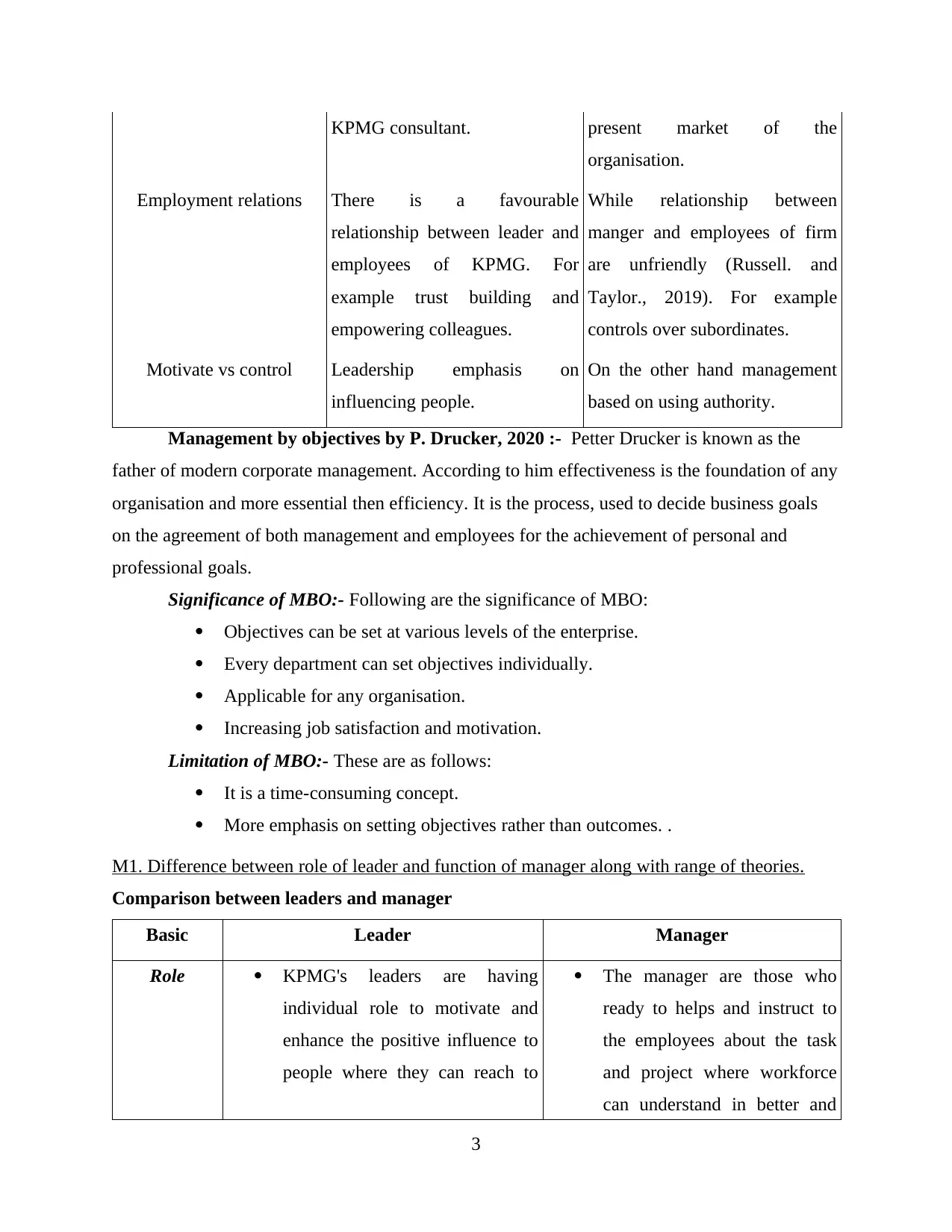
KPMG consultant. present market of the
organisation.
Employment relations There is a favourable
relationship between leader and
employees of KPMG. For
example trust building and
empowering colleagues.
While relationship between
manger and employees of firm
are unfriendly (Russell. and
Taylor., 2019). For example
controls over subordinates.
Motivate vs control Leadership emphasis on
influencing people.
On the other hand management
based on using authority.
Management by objectives by P. Drucker, 2020 :- Petter Drucker is known as the
father of modern corporate management. According to him effectiveness is the foundation of any
organisation and more essential then efficiency. It is the process, used to decide business goals
on the agreement of both management and employees for the achievement of personal and
professional goals.
Significance of MBO:- Following are the significance of MBO:
Objectives can be set at various levels of the enterprise.
Every department can set objectives individually.
Applicable for any organisation.
Increasing job satisfaction and motivation.
Limitation of MBO:- These are as follows:
It is a time-consuming concept.
More emphasis on setting objectives rather than outcomes. .
M1. Difference between role of leader and function of manager along with range of theories.
Comparison between leaders and manager
Basic Leader Manager
Role KPMG's leaders are having
individual role to motivate and
enhance the positive influence to
people where they can reach to
The manager are those who
ready to helps and instruct to
the employees about the task
and project where workforce
can understand in better and
3
organisation.
Employment relations There is a favourable
relationship between leader and
employees of KPMG. For
example trust building and
empowering colleagues.
While relationship between
manger and employees of firm
are unfriendly (Russell. and
Taylor., 2019). For example
controls over subordinates.
Motivate vs control Leadership emphasis on
influencing people.
On the other hand management
based on using authority.
Management by objectives by P. Drucker, 2020 :- Petter Drucker is known as the
father of modern corporate management. According to him effectiveness is the foundation of any
organisation and more essential then efficiency. It is the process, used to decide business goals
on the agreement of both management and employees for the achievement of personal and
professional goals.
Significance of MBO:- Following are the significance of MBO:
Objectives can be set at various levels of the enterprise.
Every department can set objectives individually.
Applicable for any organisation.
Increasing job satisfaction and motivation.
Limitation of MBO:- These are as follows:
It is a time-consuming concept.
More emphasis on setting objectives rather than outcomes. .
M1. Difference between role of leader and function of manager along with range of theories.
Comparison between leaders and manager
Basic Leader Manager
Role KPMG's leaders are having
individual role to motivate and
enhance the positive influence to
people where they can reach to
The manager are those who
ready to helps and instruct to
the employees about the task
and project where workforce
can understand in better and
3
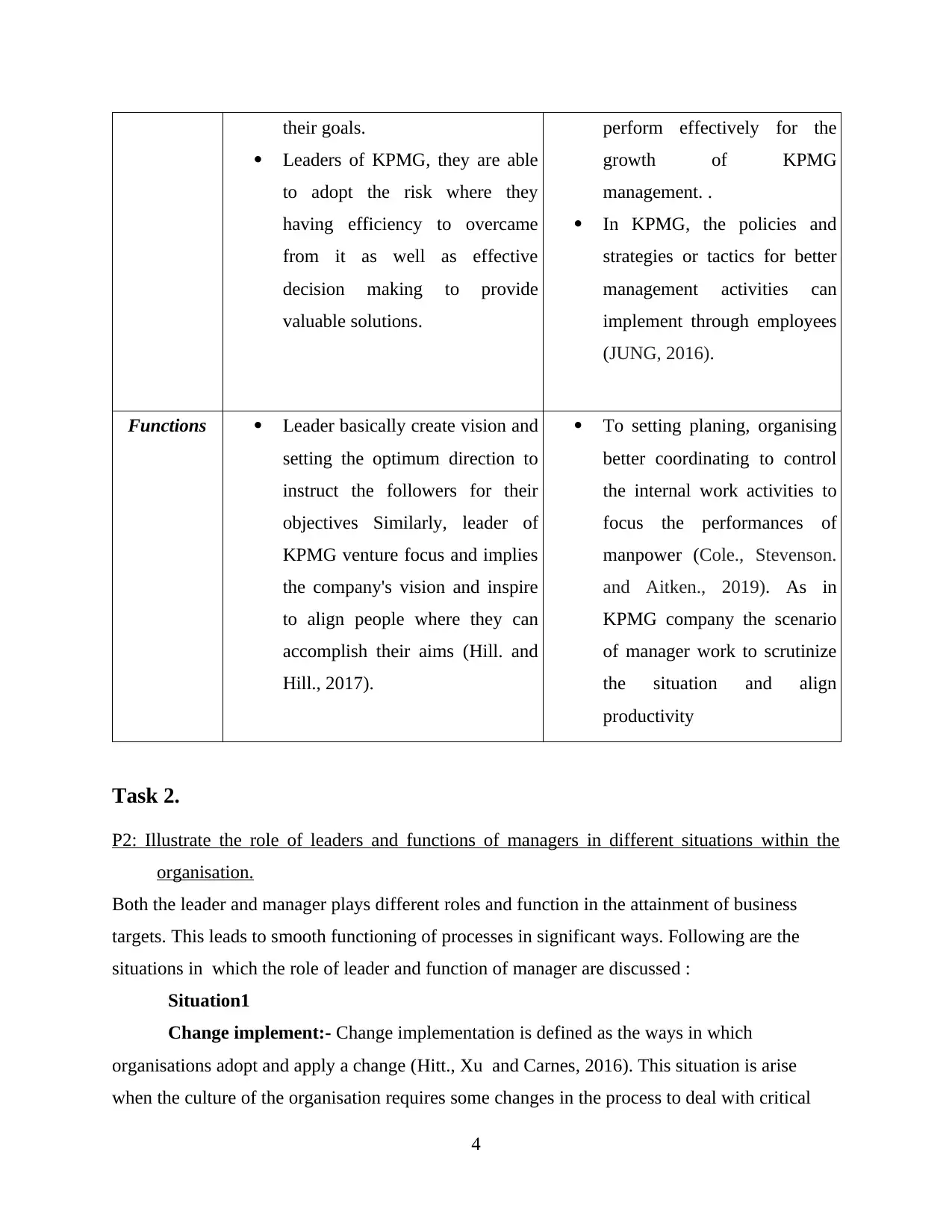
their goals.
Leaders of KPMG, they are able
to adopt the risk where they
having efficiency to overcame
from it as well as effective
decision making to provide
valuable solutions.
perform effectively for the
growth of KPMG
management. .
In KPMG, the policies and
strategies or tactics for better
management activities can
implement through employees
(JUNG, 2016).
Functions Leader basically create vision and
setting the optimum direction to
instruct the followers for their
objectives Similarly, leader of
KPMG venture focus and implies
the company's vision and inspire
to align people where they can
accomplish their aims (Hill. and
Hill., 2017).
To setting planing, organising
better coordinating to control
the internal work activities to
focus the performances of
manpower (Cole., Stevenson.
and Aitken., 2019). As in
KPMG company the scenario
of manager work to scrutinize
the situation and align
productivity
Task 2.
P2: Illustrate the role of leaders and functions of managers in different situations within the
organisation.
Both the leader and manager plays different roles and function in the attainment of business
targets. This leads to smooth functioning of processes in significant ways. Following are the
situations in which the role of leader and function of manager are discussed :
Situation1
Change implement:- Change implementation is defined as the ways in which
organisations adopt and apply a change (Hitt., Xu and Carnes, 2016). This situation is arise
when the culture of the organisation requires some changes in the process to deal with critical
4
Leaders of KPMG, they are able
to adopt the risk where they
having efficiency to overcame
from it as well as effective
decision making to provide
valuable solutions.
perform effectively for the
growth of KPMG
management. .
In KPMG, the policies and
strategies or tactics for better
management activities can
implement through employees
(JUNG, 2016).
Functions Leader basically create vision and
setting the optimum direction to
instruct the followers for their
objectives Similarly, leader of
KPMG venture focus and implies
the company's vision and inspire
to align people where they can
accomplish their aims (Hill. and
Hill., 2017).
To setting planing, organising
better coordinating to control
the internal work activities to
focus the performances of
manpower (Cole., Stevenson.
and Aitken., 2019). As in
KPMG company the scenario
of manager work to scrutinize
the situation and align
productivity
Task 2.
P2: Illustrate the role of leaders and functions of managers in different situations within the
organisation.
Both the leader and manager plays different roles and function in the attainment of business
targets. This leads to smooth functioning of processes in significant ways. Following are the
situations in which the role of leader and function of manager are discussed :
Situation1
Change implement:- Change implementation is defined as the ways in which
organisations adopt and apply a change (Hitt., Xu and Carnes, 2016). This situation is arise
when the culture of the organisation requires some changes in the process to deal with critical
4
⊘ This is a preview!⊘
Do you want full access?
Subscribe today to unlock all pages.

Trusted by 1+ million students worldwide
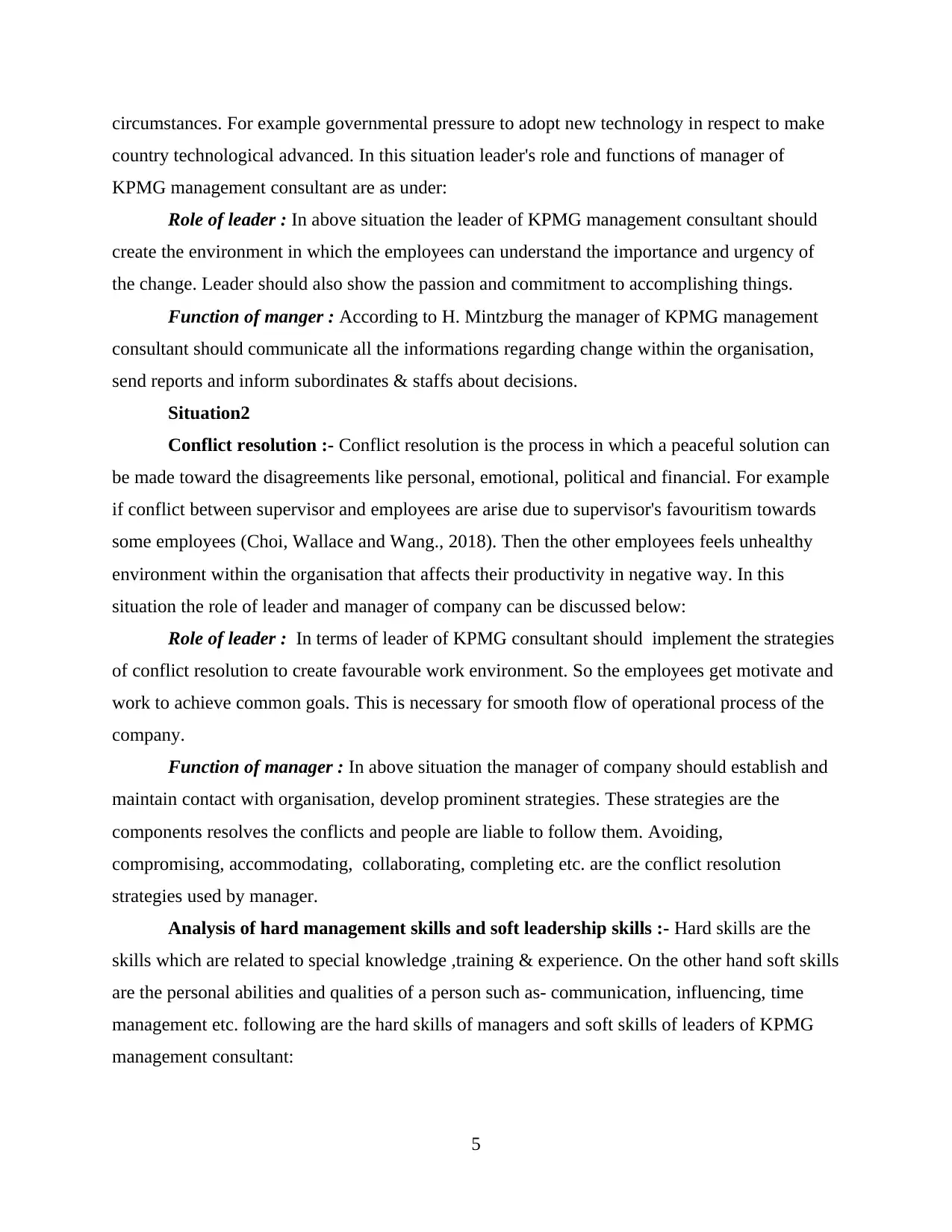
circumstances. For example governmental pressure to adopt new technology in respect to make
country technological advanced. In this situation leader's role and functions of manager of
KPMG management consultant are as under:
Role of leader : In above situation the leader of KPMG management consultant should
create the environment in which the employees can understand the importance and urgency of
the change. Leader should also show the passion and commitment to accomplishing things.
Function of manger : According to H. Mintzburg the manager of KPMG management
consultant should communicate all the informations regarding change within the organisation,
send reports and inform subordinates & staffs about decisions.
Situation2
Conflict resolution :- Conflict resolution is the process in which a peaceful solution can
be made toward the disagreements like personal, emotional, political and financial. For example
if conflict between supervisor and employees are arise due to supervisor's favouritism towards
some employees (Choi, Wallace and Wang., 2018). Then the other employees feels unhealthy
environment within the organisation that affects their productivity in negative way. In this
situation the role of leader and manager of company can be discussed below:
Role of leader : In terms of leader of KPMG consultant should implement the strategies
of conflict resolution to create favourable work environment. So the employees get motivate and
work to achieve common goals. This is necessary for smooth flow of operational process of the
company.
Function of manager : In above situation the manager of company should establish and
maintain contact with organisation, develop prominent strategies. These strategies are the
components resolves the conflicts and people are liable to follow them. Avoiding,
compromising, accommodating, collaborating, completing etc. are the conflict resolution
strategies used by manager.
Analysis of hard management skills and soft leadership skills :- Hard skills are the
skills which are related to special knowledge ,training & experience. On the other hand soft skills
are the personal abilities and qualities of a person such as- communication, influencing, time
management etc. following are the hard skills of managers and soft skills of leaders of KPMG
management consultant:
5
country technological advanced. In this situation leader's role and functions of manager of
KPMG management consultant are as under:
Role of leader : In above situation the leader of KPMG management consultant should
create the environment in which the employees can understand the importance and urgency of
the change. Leader should also show the passion and commitment to accomplishing things.
Function of manger : According to H. Mintzburg the manager of KPMG management
consultant should communicate all the informations regarding change within the organisation,
send reports and inform subordinates & staffs about decisions.
Situation2
Conflict resolution :- Conflict resolution is the process in which a peaceful solution can
be made toward the disagreements like personal, emotional, political and financial. For example
if conflict between supervisor and employees are arise due to supervisor's favouritism towards
some employees (Choi, Wallace and Wang., 2018). Then the other employees feels unhealthy
environment within the organisation that affects their productivity in negative way. In this
situation the role of leader and manager of company can be discussed below:
Role of leader : In terms of leader of KPMG consultant should implement the strategies
of conflict resolution to create favourable work environment. So the employees get motivate and
work to achieve common goals. This is necessary for smooth flow of operational process of the
company.
Function of manager : In above situation the manager of company should establish and
maintain contact with organisation, develop prominent strategies. These strategies are the
components resolves the conflicts and people are liable to follow them. Avoiding,
compromising, accommodating, collaborating, completing etc. are the conflict resolution
strategies used by manager.
Analysis of hard management skills and soft leadership skills :- Hard skills are the
skills which are related to special knowledge ,training & experience. On the other hand soft skills
are the personal abilities and qualities of a person such as- communication, influencing, time
management etc. following are the hard skills of managers and soft skills of leaders of KPMG
management consultant:
5
Paraphrase This Document
Need a fresh take? Get an instant paraphrase of this document with our AI Paraphraser
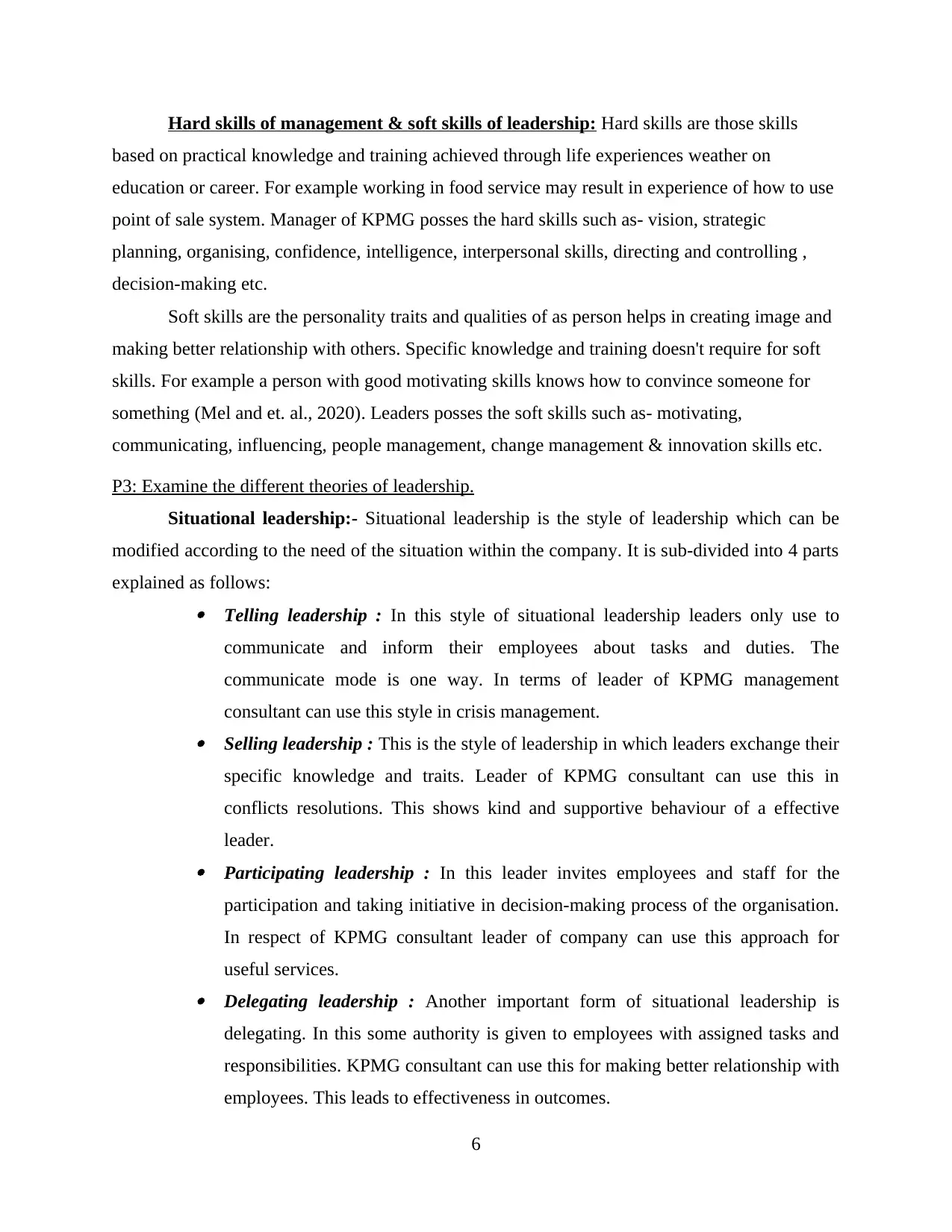
Hard skills of management & soft skills of leadership: Hard skills are those skills
based on practical knowledge and training achieved through life experiences weather on
education or career. For example working in food service may result in experience of how to use
point of sale system. Manager of KPMG posses the hard skills such as- vision, strategic
planning, organising, confidence, intelligence, interpersonal skills, directing and controlling ,
decision-making etc.
Soft skills are the personality traits and qualities of as person helps in creating image and
making better relationship with others. Specific knowledge and training doesn't require for soft
skills. For example a person with good motivating skills knows how to convince someone for
something (Mel and et. al., 2020). Leaders posses the soft skills such as- motivating,
communicating, influencing, people management, change management & innovation skills etc.
P3: Examine the different theories of leadership.
Situational leadership:- Situational leadership is the style of leadership which can be
modified according to the need of the situation within the company. It is sub-divided into 4 parts
explained as follows:
Telling leadership : In this style of situational leadership leaders only use to
communicate and inform their employees about tasks and duties. The
communicate mode is one way. In terms of leader of KPMG management
consultant can use this style in crisis management.
Selling leadership : This is the style of leadership in which leaders exchange their
specific knowledge and traits. Leader of KPMG consultant can use this in
conflicts resolutions. This shows kind and supportive behaviour of a effective
leader.
Participating leadership : In this leader invites employees and staff for the
participation and taking initiative in decision-making process of the organisation.
In respect of KPMG consultant leader of company can use this approach for
useful services.
Delegating leadership : Another important form of situational leadership is
delegating. In this some authority is given to employees with assigned tasks and
responsibilities. KPMG consultant can use this for making better relationship with
employees. This leads to effectiveness in outcomes.
6
based on practical knowledge and training achieved through life experiences weather on
education or career. For example working in food service may result in experience of how to use
point of sale system. Manager of KPMG posses the hard skills such as- vision, strategic
planning, organising, confidence, intelligence, interpersonal skills, directing and controlling ,
decision-making etc.
Soft skills are the personality traits and qualities of as person helps in creating image and
making better relationship with others. Specific knowledge and training doesn't require for soft
skills. For example a person with good motivating skills knows how to convince someone for
something (Mel and et. al., 2020). Leaders posses the soft skills such as- motivating,
communicating, influencing, people management, change management & innovation skills etc.
P3: Examine the different theories of leadership.
Situational leadership:- Situational leadership is the style of leadership which can be
modified according to the need of the situation within the company. It is sub-divided into 4 parts
explained as follows:
Telling leadership : In this style of situational leadership leaders only use to
communicate and inform their employees about tasks and duties. The
communicate mode is one way. In terms of leader of KPMG management
consultant can use this style in crisis management.
Selling leadership : This is the style of leadership in which leaders exchange their
specific knowledge and traits. Leader of KPMG consultant can use this in
conflicts resolutions. This shows kind and supportive behaviour of a effective
leader.
Participating leadership : In this leader invites employees and staff for the
participation and taking initiative in decision-making process of the organisation.
In respect of KPMG consultant leader of company can use this approach for
useful services.
Delegating leadership : Another important form of situational leadership is
delegating. In this some authority is given to employees with assigned tasks and
responsibilities. KPMG consultant can use this for making better relationship with
employees. This leads to effectiveness in outcomes.
6
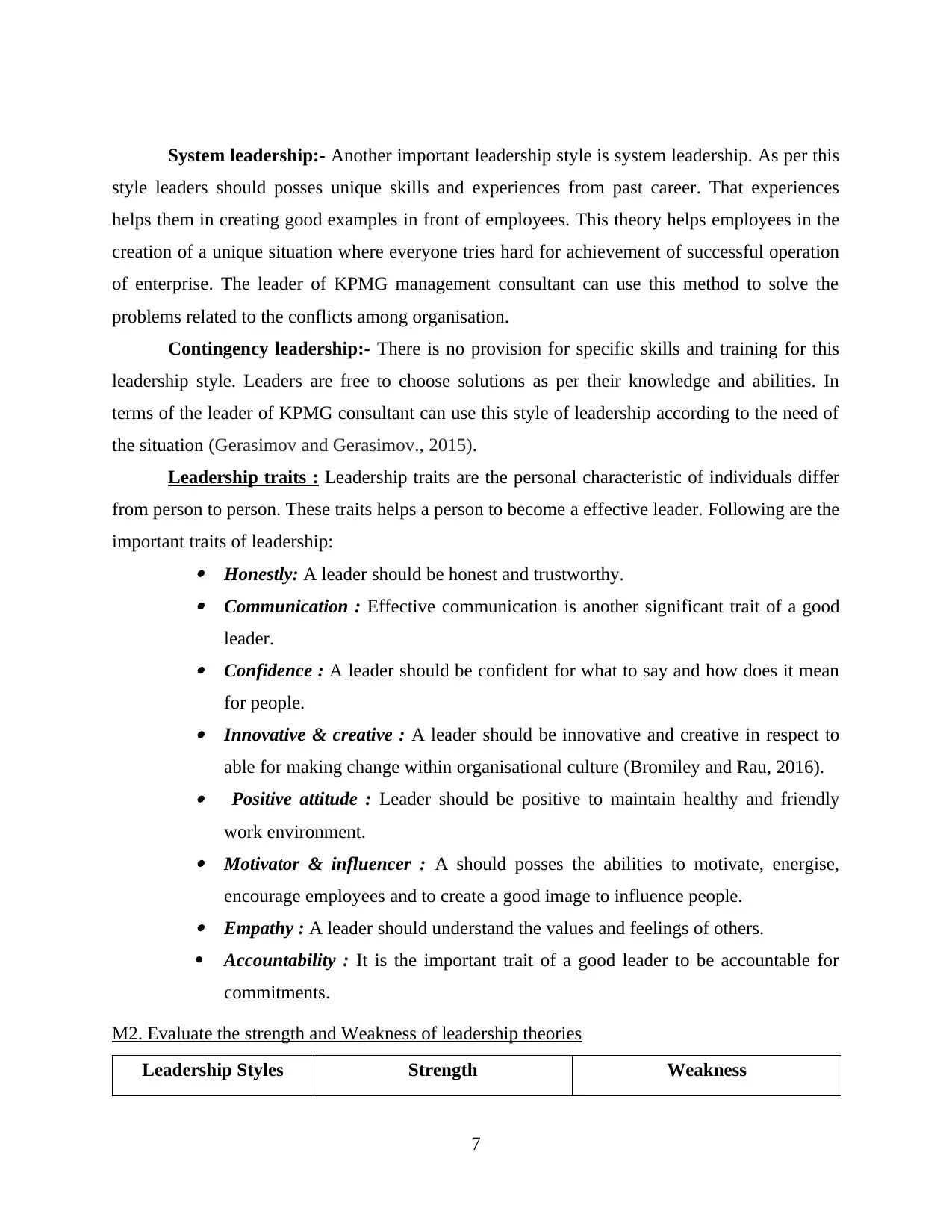
System leadership:- Another important leadership style is system leadership. As per this
style leaders should posses unique skills and experiences from past career. That experiences
helps them in creating good examples in front of employees. This theory helps employees in the
creation of a unique situation where everyone tries hard for achievement of successful operation
of enterprise. The leader of KPMG management consultant can use this method to solve the
problems related to the conflicts among organisation.
Contingency leadership:- There is no provision for specific skills and training for this
leadership style. Leaders are free to choose solutions as per their knowledge and abilities. In
terms of the leader of KPMG consultant can use this style of leadership according to the need of
the situation (Gerasimov and Gerasimov., 2015).
Leadership traits : Leadership traits are the personal characteristic of individuals differ
from person to person. These traits helps a person to become a effective leader. Following are the
important traits of leadership:
Honestly: A leader should be honest and trustworthy.
Communication : Effective communication is another significant trait of a good
leader.
Confidence : A leader should be confident for what to say and how does it mean
for people.
Innovative & creative : A leader should be innovative and creative in respect to
able for making change within organisational culture (Bromiley and Rau, 2016).
Positive attitude : Leader should be positive to maintain healthy and friendly
work environment.
Motivator & influencer : A should posses the abilities to motivate, energise,
encourage employees and to create a good image to influence people.
Empathy : A leader should understand the values and feelings of others.
Accountability : It is the important trait of a good leader to be accountable for
commitments.
M2. Evaluate the strength and Weakness of leadership theories
Leadership Styles Strength Weakness
7
style leaders should posses unique skills and experiences from past career. That experiences
helps them in creating good examples in front of employees. This theory helps employees in the
creation of a unique situation where everyone tries hard for achievement of successful operation
of enterprise. The leader of KPMG management consultant can use this method to solve the
problems related to the conflicts among organisation.
Contingency leadership:- There is no provision for specific skills and training for this
leadership style. Leaders are free to choose solutions as per their knowledge and abilities. In
terms of the leader of KPMG consultant can use this style of leadership according to the need of
the situation (Gerasimov and Gerasimov., 2015).
Leadership traits : Leadership traits are the personal characteristic of individuals differ
from person to person. These traits helps a person to become a effective leader. Following are the
important traits of leadership:
Honestly: A leader should be honest and trustworthy.
Communication : Effective communication is another significant trait of a good
leader.
Confidence : A leader should be confident for what to say and how does it mean
for people.
Innovative & creative : A leader should be innovative and creative in respect to
able for making change within organisational culture (Bromiley and Rau, 2016).
Positive attitude : Leader should be positive to maintain healthy and friendly
work environment.
Motivator & influencer : A should posses the abilities to motivate, energise,
encourage employees and to create a good image to influence people.
Empathy : A leader should understand the values and feelings of others.
Accountability : It is the important trait of a good leader to be accountable for
commitments.
M2. Evaluate the strength and Weakness of leadership theories
Leadership Styles Strength Weakness
7
⊘ This is a preview!⊘
Do you want full access?
Subscribe today to unlock all pages.

Trusted by 1+ million students worldwide
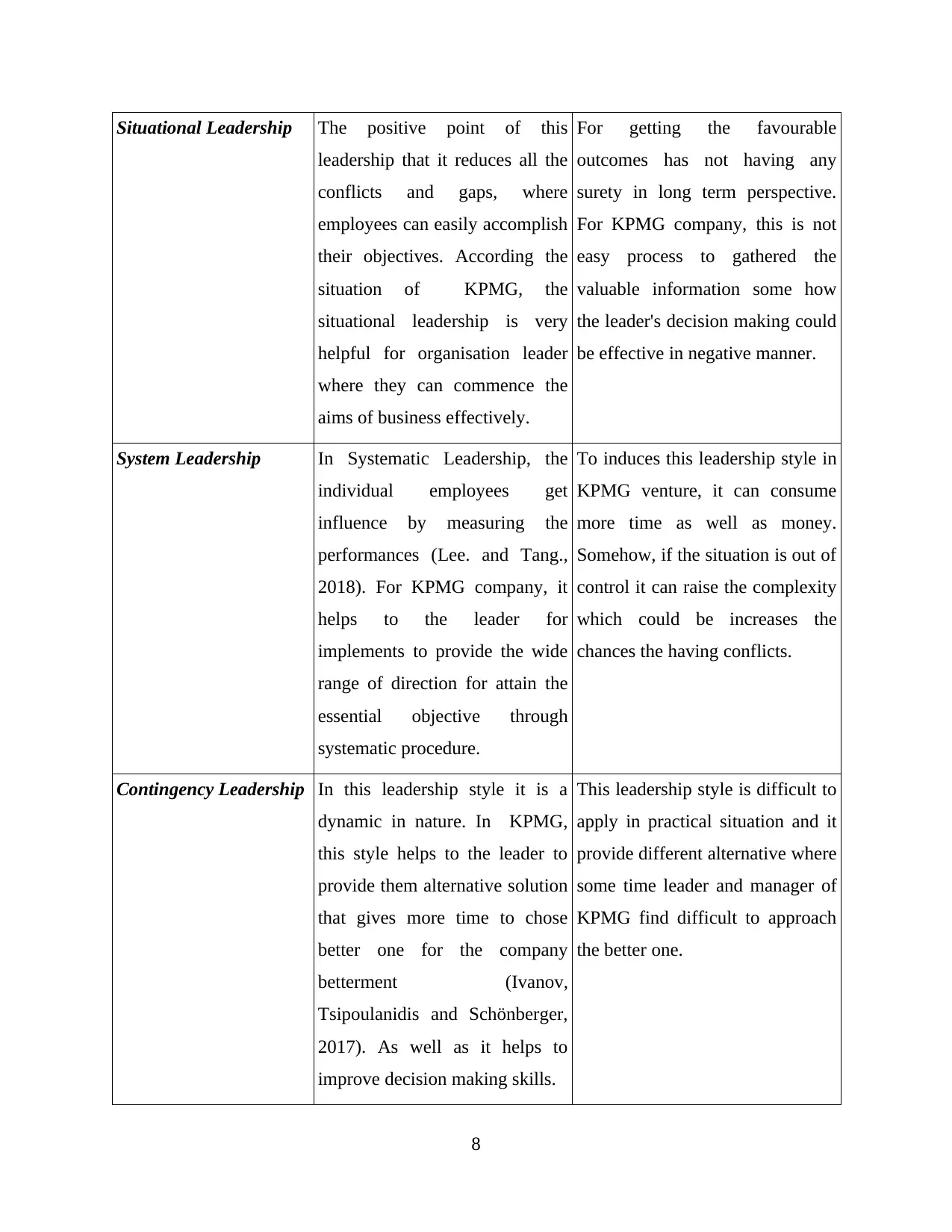
Situational Leadership The positive point of this
leadership that it reduces all the
conflicts and gaps, where
employees can easily accomplish
their objectives. According the
situation of KPMG, the
situational leadership is very
helpful for organisation leader
where they can commence the
aims of business effectively.
For getting the favourable
outcomes has not having any
surety in long term perspective.
For KPMG company, this is not
easy process to gathered the
valuable information some how
the leader's decision making could
be effective in negative manner.
System Leadership In Systematic Leadership, the
individual employees get
influence by measuring the
performances (Lee. and Tang.,
2018). For KPMG company, it
helps to the leader for
implements to provide the wide
range of direction for attain the
essential objective through
systematic procedure.
To induces this leadership style in
KPMG venture, it can consume
more time as well as money.
Somehow, if the situation is out of
control it can raise the complexity
which could be increases the
chances the having conflicts.
Contingency Leadership In this leadership style it is a
dynamic in nature. In KPMG,
this style helps to the leader to
provide them alternative solution
that gives more time to chose
better one for the company
betterment (Ivanov,
Tsipoulanidis and Schönberger,
2017). As well as it helps to
improve decision making skills.
This leadership style is difficult to
apply in practical situation and it
provide different alternative where
some time leader and manager of
KPMG find difficult to approach
the better one.
8
leadership that it reduces all the
conflicts and gaps, where
employees can easily accomplish
their objectives. According the
situation of KPMG, the
situational leadership is very
helpful for organisation leader
where they can commence the
aims of business effectively.
For getting the favourable
outcomes has not having any
surety in long term perspective.
For KPMG company, this is not
easy process to gathered the
valuable information some how
the leader's decision making could
be effective in negative manner.
System Leadership In Systematic Leadership, the
individual employees get
influence by measuring the
performances (Lee. and Tang.,
2018). For KPMG company, it
helps to the leader for
implements to provide the wide
range of direction for attain the
essential objective through
systematic procedure.
To induces this leadership style in
KPMG venture, it can consume
more time as well as money.
Somehow, if the situation is out of
control it can raise the complexity
which could be increases the
chances the having conflicts.
Contingency Leadership In this leadership style it is a
dynamic in nature. In KPMG,
this style helps to the leader to
provide them alternative solution
that gives more time to chose
better one for the company
betterment (Ivanov,
Tsipoulanidis and Schönberger,
2017). As well as it helps to
improve decision making skills.
This leadership style is difficult to
apply in practical situation and it
provide different alternative where
some time leader and manager of
KPMG find difficult to approach
the better one.
8
Paraphrase This Document
Need a fresh take? Get an instant paraphrase of this document with our AI Paraphraser
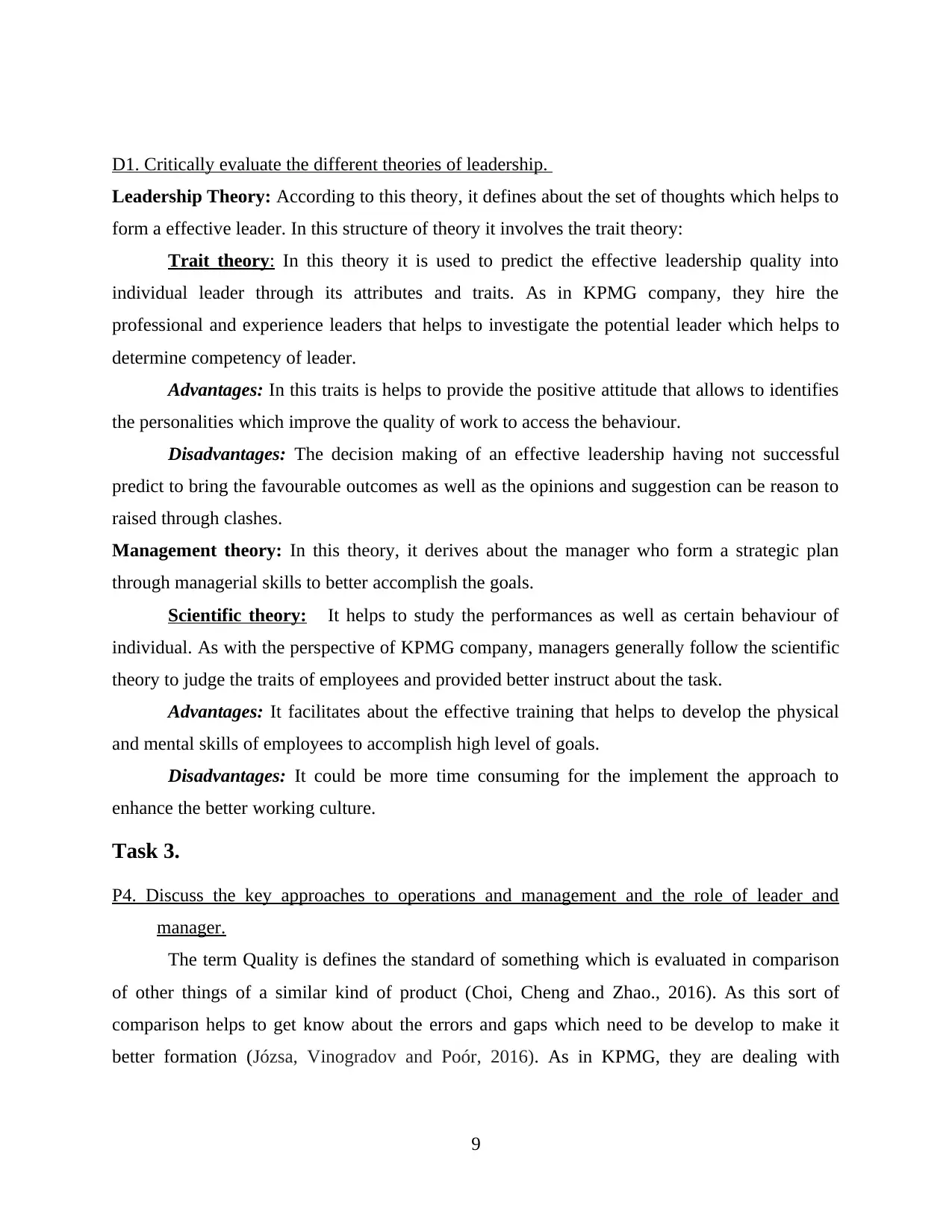
D1. Critically evaluate the different theories of leadership.
Leadership Theory: According to this theory, it defines about the set of thoughts which helps to
form a effective leader. In this structure of theory it involves the trait theory:
Trait theory: In this theory it is used to predict the effective leadership quality into
individual leader through its attributes and traits. As in KPMG company, they hire the
professional and experience leaders that helps to investigate the potential leader which helps to
determine competency of leader.
Advantages: In this traits is helps to provide the positive attitude that allows to identifies
the personalities which improve the quality of work to access the behaviour.
Disadvantages: The decision making of an effective leadership having not successful
predict to bring the favourable outcomes as well as the opinions and suggestion can be reason to
raised through clashes.
Management theory: In this theory, it derives about the manager who form a strategic plan
through managerial skills to better accomplish the goals.
Scientific theory: It helps to study the performances as well as certain behaviour of
individual. As with the perspective of KPMG company, managers generally follow the scientific
theory to judge the traits of employees and provided better instruct about the task.
Advantages: It facilitates about the effective training that helps to develop the physical
and mental skills of employees to accomplish high level of goals.
Disadvantages: It could be more time consuming for the implement the approach to
enhance the better working culture.
Task 3.
P4. Discuss the key approaches to operations and management and the role of leader and
manager.
The term Quality is defines the standard of something which is evaluated in comparison
of other things of a similar kind of product (Choi, Cheng and Zhao., 2016). As this sort of
comparison helps to get know about the errors and gaps which need to be develop to make it
better formation (Józsa, Vinogradov and Poór, 2016). As in KPMG, they are dealing with
9
Leadership Theory: According to this theory, it defines about the set of thoughts which helps to
form a effective leader. In this structure of theory it involves the trait theory:
Trait theory: In this theory it is used to predict the effective leadership quality into
individual leader through its attributes and traits. As in KPMG company, they hire the
professional and experience leaders that helps to investigate the potential leader which helps to
determine competency of leader.
Advantages: In this traits is helps to provide the positive attitude that allows to identifies
the personalities which improve the quality of work to access the behaviour.
Disadvantages: The decision making of an effective leadership having not successful
predict to bring the favourable outcomes as well as the opinions and suggestion can be reason to
raised through clashes.
Management theory: In this theory, it derives about the manager who form a strategic plan
through managerial skills to better accomplish the goals.
Scientific theory: It helps to study the performances as well as certain behaviour of
individual. As with the perspective of KPMG company, managers generally follow the scientific
theory to judge the traits of employees and provided better instruct about the task.
Advantages: It facilitates about the effective training that helps to develop the physical
and mental skills of employees to accomplish high level of goals.
Disadvantages: It could be more time consuming for the implement the approach to
enhance the better working culture.
Task 3.
P4. Discuss the key approaches to operations and management and the role of leader and
manager.
The term Quality is defines the standard of something which is evaluated in comparison
of other things of a similar kind of product (Choi, Cheng and Zhao., 2016). As this sort of
comparison helps to get know about the errors and gaps which need to be develop to make it
better formation (Józsa, Vinogradov and Poór, 2016). As in KPMG, they are dealing with
9
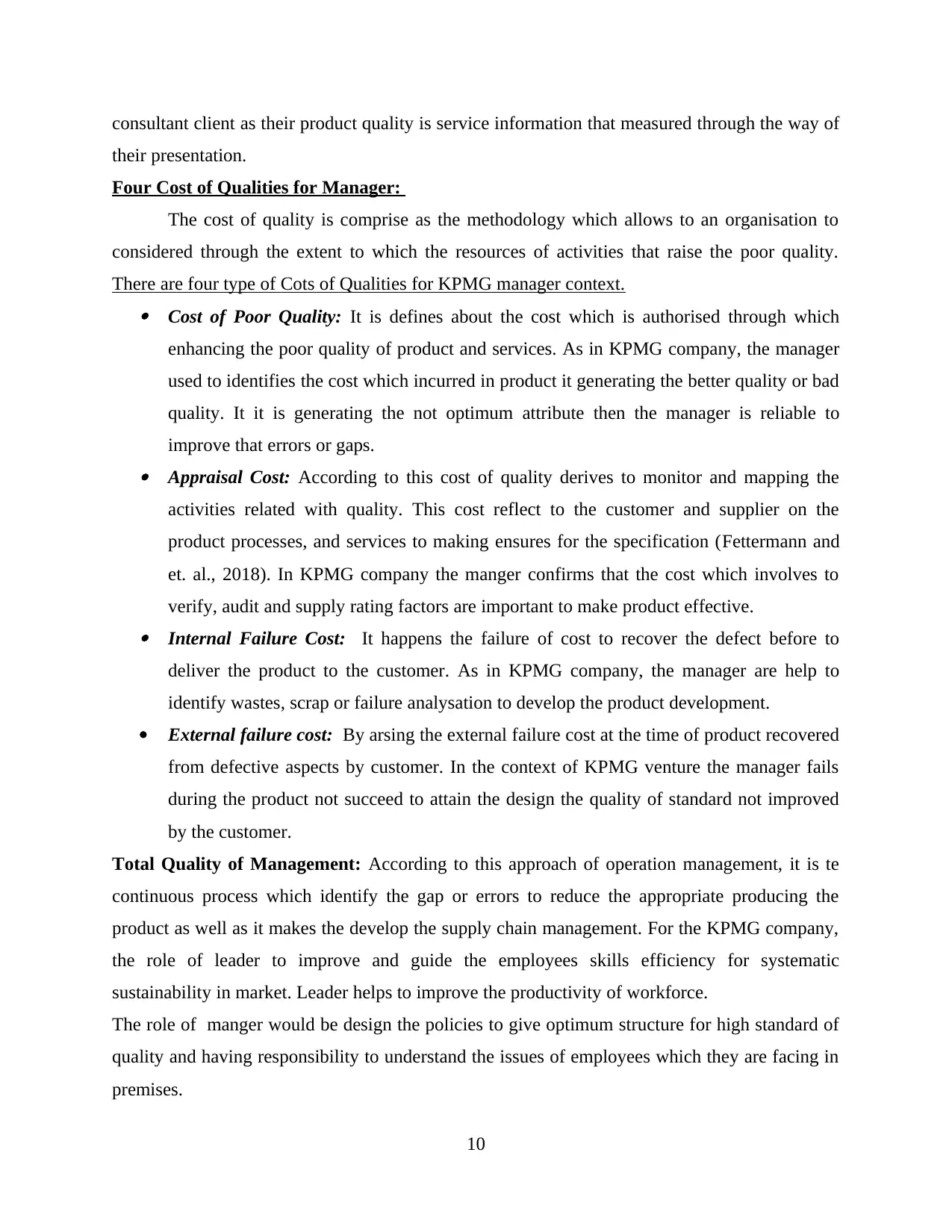
consultant client as their product quality is service information that measured through the way of
their presentation.
Four Cost of Qualities for Manager:
The cost of quality is comprise as the methodology which allows to an organisation to
considered through the extent to which the resources of activities that raise the poor quality.
There are four type of Cots of Qualities for KPMG manager context. Cost of Poor Quality: It is defines about the cost which is authorised through which
enhancing the poor quality of product and services. As in KPMG company, the manager
used to identifies the cost which incurred in product it generating the better quality or bad
quality. It it is generating the not optimum attribute then the manager is reliable to
improve that errors or gaps. Appraisal Cost: According to this cost of quality derives to monitor and mapping the
activities related with quality. This cost reflect to the customer and supplier on the
product processes, and services to making ensures for the specification (Fettermann and
et. al., 2018). In KPMG company the manger confirms that the cost which involves to
verify, audit and supply rating factors are important to make product effective. Internal Failure Cost: It happens the failure of cost to recover the defect before to
deliver the product to the customer. As in KPMG company, the manager are help to
identify wastes, scrap or failure analysation to develop the product development.
External failure cost: By arsing the external failure cost at the time of product recovered
from defective aspects by customer. In the context of KPMG venture the manager fails
during the product not succeed to attain the design the quality of standard not improved
by the customer.
Total Quality of Management: According to this approach of operation management, it is te
continuous process which identify the gap or errors to reduce the appropriate producing the
product as well as it makes the develop the supply chain management. For the KPMG company,
the role of leader to improve and guide the employees skills efficiency for systematic
sustainability in market. Leader helps to improve the productivity of workforce.
The role of manger would be design the policies to give optimum structure for high standard of
quality and having responsibility to understand the issues of employees which they are facing in
premises.
10
their presentation.
Four Cost of Qualities for Manager:
The cost of quality is comprise as the methodology which allows to an organisation to
considered through the extent to which the resources of activities that raise the poor quality.
There are four type of Cots of Qualities for KPMG manager context. Cost of Poor Quality: It is defines about the cost which is authorised through which
enhancing the poor quality of product and services. As in KPMG company, the manager
used to identifies the cost which incurred in product it generating the better quality or bad
quality. It it is generating the not optimum attribute then the manager is reliable to
improve that errors or gaps. Appraisal Cost: According to this cost of quality derives to monitor and mapping the
activities related with quality. This cost reflect to the customer and supplier on the
product processes, and services to making ensures for the specification (Fettermann and
et. al., 2018). In KPMG company the manger confirms that the cost which involves to
verify, audit and supply rating factors are important to make product effective. Internal Failure Cost: It happens the failure of cost to recover the defect before to
deliver the product to the customer. As in KPMG company, the manager are help to
identify wastes, scrap or failure analysation to develop the product development.
External failure cost: By arsing the external failure cost at the time of product recovered
from defective aspects by customer. In the context of KPMG venture the manager fails
during the product not succeed to attain the design the quality of standard not improved
by the customer.
Total Quality of Management: According to this approach of operation management, it is te
continuous process which identify the gap or errors to reduce the appropriate producing the
product as well as it makes the develop the supply chain management. For the KPMG company,
the role of leader to improve and guide the employees skills efficiency for systematic
sustainability in market. Leader helps to improve the productivity of workforce.
The role of manger would be design the policies to give optimum structure for high standard of
quality and having responsibility to understand the issues of employees which they are facing in
premises.
10
⊘ This is a preview!⊘
Do you want full access?
Subscribe today to unlock all pages.

Trusted by 1+ million students worldwide
1 out of 20
Related Documents
Your All-in-One AI-Powered Toolkit for Academic Success.
+13062052269
info@desklib.com
Available 24*7 on WhatsApp / Email
![[object Object]](/_next/static/media/star-bottom.7253800d.svg)
Unlock your academic potential
Copyright © 2020–2025 A2Z Services. All Rights Reserved. Developed and managed by ZUCOL.





